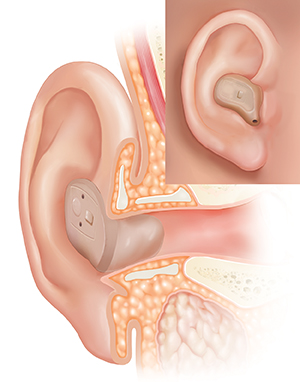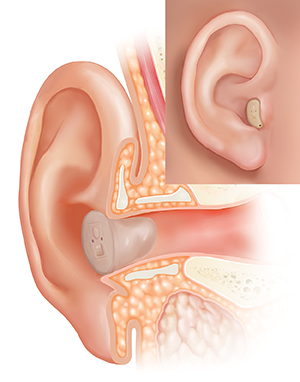Styles of Hearing Aids
The most common hearing aid styles and features are described below. Keep in mind that some styles and features cost more than others, and health insurance coverage for hearing aids varies. If you find the best hearing aids for you, though, the benefits may outweigh the cost.
In-the-ear (ITE)
-
For mild to moderate hearing loss.
-
Electrical parts are contained in a plastic case that fits into the outer ear and extends into the ear canal.
-
Hearing aid fits inside the ear, but can be seen from outside the ear.
-
Sound is sent into the ear by a receiver in the ear canal.
 |
| In-the-ear (ITE) |
In-the-canal (ITC)
-
For mild to moderately severe hearing loss.
-
Electrical parts are contained in a plastic case that fits into the ear opening and extends into the ear canal.
-
Hearing aid fits inside the ear, so it's harder to see than ITE models.
-
Sound is sent into the ear by a receiver in the ear canal.
 |
| In-the-canal (ITC) |
Open ear
-
For mild to severe hearing loss. This type is better for high-frequency hearing loss.
-
Electrical parts are contained in a plastic case hidden behind the ear; speaker pieces fit deeply into the ear canal.
-
Hearing aid is very hard to see. Clear pieces blend in with skin color.
-
Sound is sent into the ear through a plastic tube or wire to a receiver in the ear canal.
 |
| Open ear |
Completely-in-canal (CIC)
-
For mild to moderately severe hearing loss.
-
Electrical parts are contained in a plastic case that fits inside the ear canal.
-
Hearing aid can hardly be seen.
-
Sound is sent into the ear by a receiver in the ear canal.
 |
| Completely-in-canal (CIC) |
Behind-the-ear (BTE)
-
For mild to profound hearing loss.
-
Electrical parts are contained in a plastic case hidden behind the ear.
-
Casing can be seen behind the ear. Different colors and sizes are available.
-
Sound is sent into the ear through a plastic tube in the ear canal.
 |
| Behind-the-ear (BTE) |
Optional features
Extra features can tailor hearing aids to your needs. A few common ones are listed below.
-
Telecoils let you switch from the hearing aid’s microphone to a special setting that works better with phones and in certain auditoriums, theaters, and museums that have telecoil-compatible sound systems.
-
Direct audio input feeds sound from a sound system, computer, radio, or microphone directly into your hearing aids.
-
Directional microphones pick up head-on sounds and reduce background noise.
-
Customized listening programs store programs to adapt to changes in noise level. For example, you can have one program for your home and another for crowds.
Noncustom type hearing aids
The hearing aids shown here are customized based on the shape of your ear and the type of hearing loss you have. Noncustom (ready-to-wear) hearing aids may also be a choice. These are often purchased through mail order or over the counter. Noncustom hearing aids may cost less than custom hearing aids. But they may not work as well because they have not been programmed for your specific hearing needs. And since they’re not made to fit the shape of your ear, noncustom hearing aids may not be as comfortable. Your hearing healthcare provider can help you decide which type is best for you.
Online Medical Reviewer:
Ashutosh Kacker MD
Online Medical Reviewer:
Rita Sather RN
Online Medical Reviewer:
Tara Novick BSN MSN
Date Last Reviewed:
3/1/2022
© 2000-2024 The StayWell Company, LLC. All rights reserved. This information is not intended as a substitute for professional medical care. Always follow your healthcare professional's instructions.